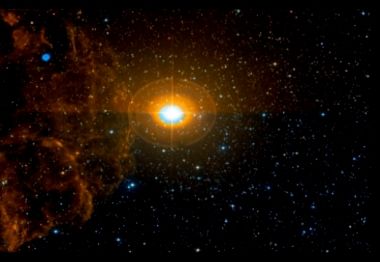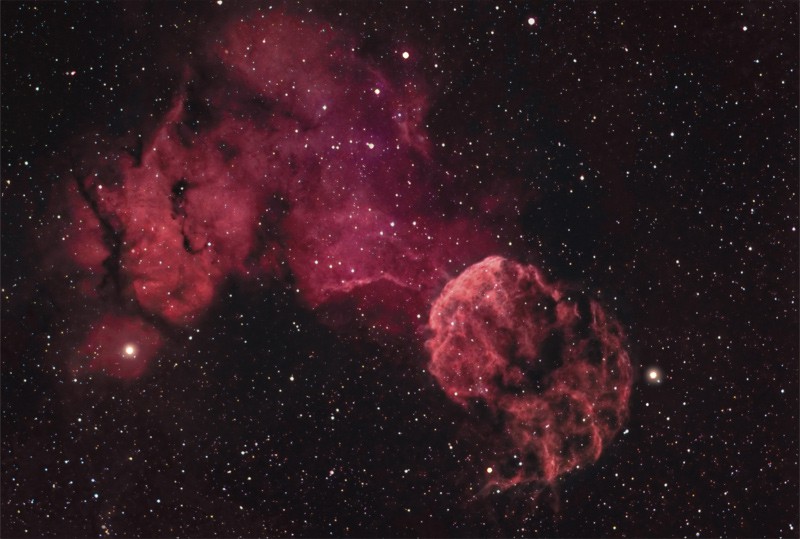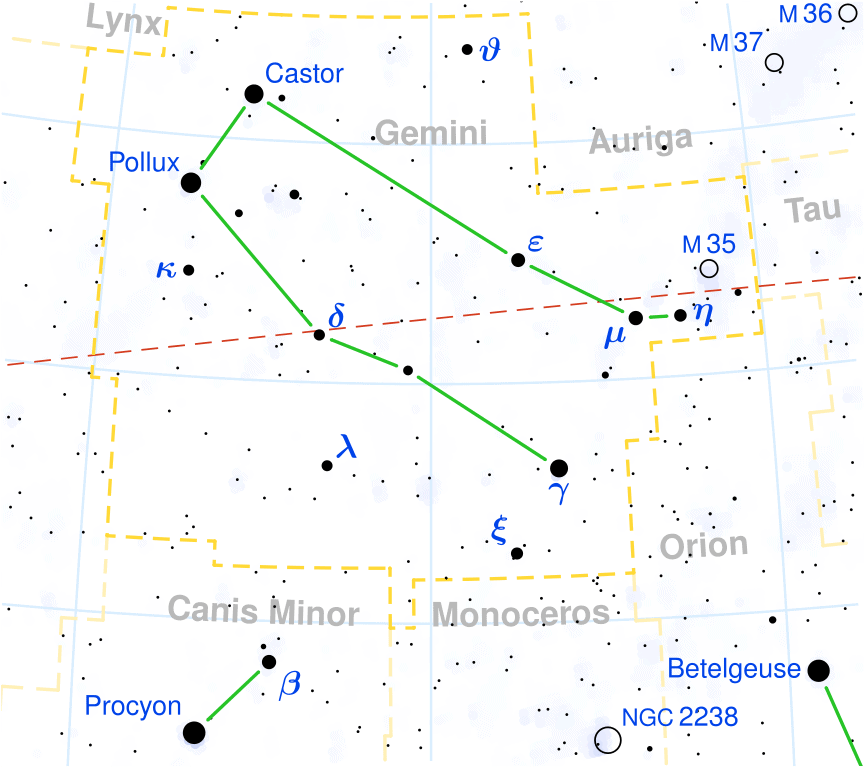Propus, also known as Eta Geminorum, is a triple star system in the zodiacal constellation of Gemini, the twins. It is the seventh brightest star in the constellation and it is visible to the naked eye.
Key Facts & Summary
- The Eta Geminorum star system is located at around 380 light-years / 120 parsecs away from the Sun.
- Eta Geminorum is a semiregular variable star and since it has a gravitationally bound component, it is also an Algol-type variable binary system. The third component is visually associated with the Ete Geminorum star system however, it may be gravitationally bound to the primary star as well.
- The primary star, Eta Geminorum Aa, varies in its apparent brightness from an apparent magnitude of 3.15 to 3.90.
- Its absolute magnitude has been estimated to be at around -1.87, this applies to the star system as a whole.
- Eta Geminorum Aa is an asymptotic giant branch star of spectral type M2 IIIa.
- It is much bigger than our Sun, having 250% of our sun’s mass and a whopping 15.300% of the sun’s radius.
- Eta Geminorum Aa is a highly evolved cool luminous star, much cooler than our sun. The average surface temperatures have been estimated to be at around 3.548 K.
- Eta Geminorum Aa is much more energetic than our sun, being 3.162 times more luminous.
- The secondary star, Ete Geminorum Ab, is suspected to be a much smaller star. Little is known about it other than its proximity and orbit in regards to the primary star.
- The third star, Eta Geminorum B, is a 6th magnitude star of spectral type G0 III.
- Eta Geminorum B has an apparent magnitude of 6.04 and it is separated from the primary star by a distance of around 1.65 arcseconds.
- Eta Geminorum B is suspected of being a much fainter M-class star. Little is known about this star as well.
Propus bore many names throughout the ages. The name Propus, and Tejat Prior, are of Greek origin and translates to “forward foot.” This refers to the star’s position in its constellation, marking the right foot of one of the celestial twins, Castor.

Some other names are of Persian origins, such as Praepes and Pish Pai, meaning “foreleg”. In late 2016, the IAU organized the WGSN and finally approved the name Propus, for Eta Geminorum.
Formation
The primary star of the Eta Geminorum star system formed roughly 0.81 billion years ago. It is unknown when the other stars were formed or if the stars themselves can be associated with any group of moving stars.
Eta Geminorum most likely formed from an abundance of gas and dust. Gravity ultimately pulled the gas and dust together and resulted in the star which mark’s the right foot of the celestial twin Castor, Eta Geminorum.
Distance, Size, and Mass
The Eta Geminorum star system is located at around 380 light-years / 120 parsecs away from the Sun. It is the seventh brightest star in its constellation and a very bright star that can be observed even with the naked eye.

The primary star, Eta Geminorum Aa, is much bigger than our Sun, having 250% of our sun’s mass or 2.5 solar masses, and a whopping 15.300% of the sun’s radius, or 153 solar radii. Since a star’s diameter is usually double its radius, but this is not always the case, Eta Geminorum is either 153 times bigger than our sun, or more than 300 times bigger.
Other Characteristics
The primary star, Eta Geminorum Aa, is an asymptotic giant branch star of spectral type M2 IIIa. The star is also classified both as a semiregular variable star, and an eclipsing variable.
Its apparent brightness changes from an apparent magnitude of 3.15 to 3.90, in a period of around 234 days. Its absolute magnitude has been estimated to be at around -1.87. The eclipsing period has been determined to last around 8 years, corresponding to the orbit of an unseen companion.
These eclipses have long been questioned and observations are still being conducted in order to establish their predictability. Eta Geminorum Aa is a highly evolved cool luminous star, much cooler than our sun. The average surface temperatures have been estimated to be at around 3.548 K. Thus, it is more than 2.000 Kelvins cooler than the sun.

Eta Geminorum Aa is more energetic than our sun, being 3.162 times more luminous. Its companion, Eta Geminorum B, is a 6th magnitude star of spectral type G0 III.
Eta Geminorum B has an apparent magnitude of 6.04 and it is suspected of being a much fainter M-class star. Little is known about this star as well. The third component, Eta Geminorum Ab has yet to be observed. It is though very likely much smaller than the primary star.
Stellar System
Eta Geminorum B is separated by Eta Geminorum A by a distance of around 1.65 arcseconds. Some estimates point out that the secondary star orbits the primary star, once every 473.7 years. The semi-major axis has been estimated to be 1.08 while its orbit eccentricity at 0.54.

The third companion is blamed for the eclipsing periods. It has been determined that these periods last around 8 years, corresponding to the orbit of the unseen companion designated Ete Geminorum Ab, which completes one orbit around Eta Geminoruam Aa, once every 8.17 years. The semi-major axis has been estimated to be 0.077 while its orbit eccentricity at around 0.53.
Location
Eta Gemonirum is located in the zodiacal constellation of Gemini, the celestial twins. Its position in the constellation marks the right foot of the celestial twin, Castor.

Eta Geminorum is located at around 2 degrees west of Mu Geminorum, and two degrees southeast of the bright open cluster M35.
Probably the best month to observe the constellation and all of its deep-sky objects and stars is during the month of February – this is when it is the most prominent.
The Future
Eta Geminorum is an evolved cool luminous star currently in a period of stellar evolution undertaken by all low to intermediate-mass stars late in their life. Red dwarfs have usually been associated with the M class spectral classification as well as red giant stars. It is possible that Eta Geminorum will become a red giant star such as Aldebaran or Arcturus in the future after completing its AGB stage.
Did you know?
- Among the stars of the Gemini constellation, Pollux is the only one listed among the 58 selected stars for navigation.
- The constellation of Gemini is the northernmost of the zodiacal constellations and among the brightest.
- Since Eta Geminorum is 09 degrees south of the ecliptic, it can be occulted by the Moon, and rarely, by planets.
- The last time Eta Geminorum was occulted by a planet, was on the 27th of July, 1910, it was occulted by Venus. Another recorded occultation occurred on the 11th of July, 1837, when Mercury occulted Eta Geminorum.
Sources:
Image source:
- https://i.pinimg.com/originals/d0/bf/9f/d0bf9fbc0752af9bd7d0e9a1cfa1289e.jpg
- https://www.constellationsofwords.com/images/stars/propus.JPG
- https://upload.wikimedia.org/wikipedia/commons/1/14/Ic443_wide.jpg
- https://upload.wikimedia.org/wikipedia/commons/thumb/9/94/IC_443.jpg/330px-IC_443.jpg
- https://upload.wikimedia.org/wikipedia/commons/thumb/b/bf/Gemini_constellation_map.svg/420px-Gemini_constellation_map.svg.png
